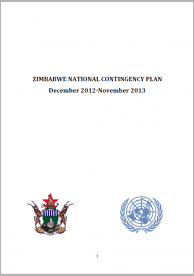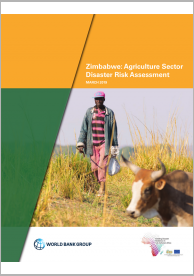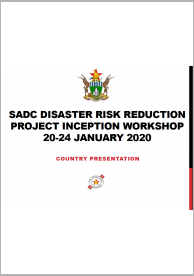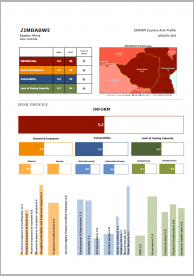Zimbabwe is a high-risk country based on the 2019 INFORM Risk value. Main hazards include floods and droughts as the most severe. The country is also vulnerable to the compound risk of food insecurity, linked with extreme weather events and agricultural output. The lack of coping capacity is the factor of the highest index value and calls for increased efforts for resilience.
The Department of Civil Protection is the operational arm regarding DRR. The National Civil Protection Committee (NCPC) is an advisory entity, with several stakeholders, including governmental, NGOs, the UN, and the private sector. There are national and provincial planning committees and subcommittees that might be established on a need’s basis. The system is complemented by a decentralized structure, at the provincial level and in areas or districts within provinces.
Zimbabwe’s DRR system is governed by the Civil Protection Act. The country has a disaster risk management bill under development, which will align with the Sendai Framework and revise the structure to better account for available national financial resources. The National Climate Change Response Strategy calls for integrated and coordinated approaches to climate change mitigation and DRR.
Zimbabwe, formerly Rhodesia, is a country located in southern Africa, just north of the Tropic of Capricorn, and almost entirely occupied by a plateau, at an altitude between 1,200 and 1,600 meters, which tempers the climate. There are three main seasons:
- a rainy season, hot and humid, from mid-November to mid-March, followed by a period, from mid-March to mid-May, when the rains become rare but the temperatures are still high;
- a cool season, dry and sunny, from mid-May to mid-August;
- and a period of intense heat at the end of the dry season, between mid-August and mid-November, before the rains that come during the month of November, and are able to lower a bit the temperature while increasing relative humidity.
This kind of climate, with a long dry season, produces almost everywhere a savannah landscape, except in the highest mountains, where forests are found. The highest peak is Mount Nyangani, 2,592 meters high, located in the east, in the Nyanga National Park.
In much of the country, annual rainfall ranges from 550 to 900 millimeters. The rains occur primarily in the form of showers and thunderstorms in the afternoon. The wettest regions are the north and the east, while the driest region is the south, in the Limpopo Valley, on the border with South Africa, where rainfall drops below 400 mm per year.
In the latter region, the altitude drops to around 500/600 meters, while in the south-eastern strip, at the border with Mozambique, where the Gonarezhou National Park is found, it goes down to around 200/300 meters. Another area where the altitude drops to around 500 meters is found in the north and is that of Lake Kariba. It goes without saying that the areas where the altitude is lower are also the hottest, and in October and November, highs can reach 40°C.

Regional Platform / DRR Contact Point
-
Government of ZimbabweOrganization type:
Risk reduction Policies, Plans & Strategies
Policies, plans and official statements on disaster risk, climate adaptation and resilience.

|
Zimbabwe Climate Policy
The objective of this Policy is to guide climate change management in the country, enhance the national adaptive captive, scale up mitigation actions, facilitate domestication of global policies and ensure compliance to the global mechanisms. |

|
Zimbabwe's National Climate Change Response Strategy
Zimbabwe’s Climate Change Response Strategy mainstreams climate change through a sectorial approach to ensure that each sector implements adaptation and mitigation actions. Each sector will therefore be able to direct its project proposals to the appropriate funding mechanism. |

|
Zimbabwe National Contingency Plan 2012-2013
The overall objective of the National Contingency Plan is to help ensure that Government, partners and civil society mount a timely, consistent and coordinated response to anticipated hazards during the 2012–2013 planning period in order to minimise potential humanitarian consequences and initiat |
Documents & Publications
Disaster risk reduction and resilience publications, reports, research papers and case studies.

|
Zimbabwe agriculture sector disaster risk assessment report
This report presents an assessment of Zimbabwe’s agriculture sector disaster risk and management capacity. The findings indicate that Zimbabwe is highly exposed to agricultural risks and has limited capacity to manage risk at various levels. |

|
Zimbabwe Presentation - SADC DRR Project Inception Workshop
Zimbabwe presentation in the Strengthening Disaster Risk Reduction, Coordination, Planning and Policy Advisory Capacity of SADC Project Inception Workshop, held in Johannesburg, South Africa, 20-24 January 2020. |

|
RIASCO Humanitarian Outlook for Southern Africa | November 2017-April 2018
This report analyses some of the southern african countries readiness to humanitarian impacts related to their macro-economic conditions, the regional seasonal rainfall forecast, the food, livelihood and nutrition security and the conflict in Democratic Republic of Congo. |
Disaster Data & Statistics
Reports on disaster statistics, country profiles and additional resources on collecting disaster loss data.

|
INFORM Country Risk Profile - Zimbabwe
Index for Risk Management. |

